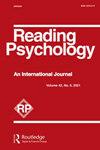早期阅读教学语言:印刷品曝光的相关性
IF 1
Q4 PSYCHOLOGY, EDUCATIONAL
引用次数: 0
摘要
摘要马太效应表明,与快速阅读的孩子相比,在学习阅读时挣扎的孩子在以后的生活中不太可能为了快乐而阅读。早期识字教学可能会阻碍阅读进度的一个方面是学习同时用两种语言阅读。尽管双语有着长期而广泛的好处,但早期阅读发展的挫折可能会对以后的阅读习惯产生持久的影响。我们调查了目前学习第一语言阅读的成年人与学习两种语言阅读的人的印刷品接触情况是否不同。成年人完成了:双语作者识别、视听识别以及英语和法语单词识别测试。报告用第一语言进行阅读教学的参与者比用两种语言学习阅读的参与者认可更多的作者。这些第一语言学习者也更善于识别真正的英语单词。双语学习者在相应的任务中更善于识别真正的法语单词。最后,两组的观看习惯相似。这项回顾性研究的结果与马太效应一致,并表明一年级和二年级对第一语言阅读教学的关注仍然与印刷品暴露相关25 几年后。本文章由计算机程序翻译,如有差异,请以英文原文为准。
Language of Early Reading Instruction: A Correlate of Print Exposure
Abstract The Matthew effects suggest that children who struggle when learning to read are less likely to read for pleasure later in life compared to children who ease into reading quickly. One aspect of early literacy instruction that might hamper reading progress is learning to read simultaneously in two languages. Despite the long-lasting and widespread benefits of bilingualism, early setbacks in reading development might carry lasting effects for later reading habits. We investigated whether present-day print exposure of adults who learned to read in their first language were different from those who learned to read in two languages. Adults completed: Bilingual Author Recognition, Viewing Recognition, and English and French Word Recognition Tests. Participants who reported that reading instruction took place in their first language recognized more authors than those who learned to read in two languages. These first-language learners were also better at identifying real English words. Bilingual learners were superior at identifying real French words on the corresponding task. Lastly, both groups demonstrated similar viewing habits. The findings from this retrospective study align with the Matthew effects and suggest that a focus on first language reading instruction in Grades 1 and 2 remains correlated with print exposure 25 years later.
求助全文
通过发布文献求助,成功后即可免费获取论文全文。
去求助
来源期刊

Reading Psychology
PSYCHOLOGY, EDUCATIONAL-
CiteScore
2.20
自引率
7.10%
发文量
28
期刊介绍:
Prepared exclusively by professionals, this refereed journal publishes original manuscripts in the fields of literacy, reading, and related psychology disciplines. Articles appear in the form of completed research; practitioner-based "experiential" methods or philosophical statements; teacher and counselor preparation services for guiding all levels of reading skill development, attitudes, and interests; programs or materials; and literary or humorous contributions.
 求助内容:
求助内容: 应助结果提醒方式:
应助结果提醒方式:


